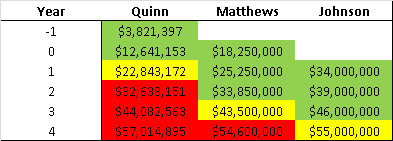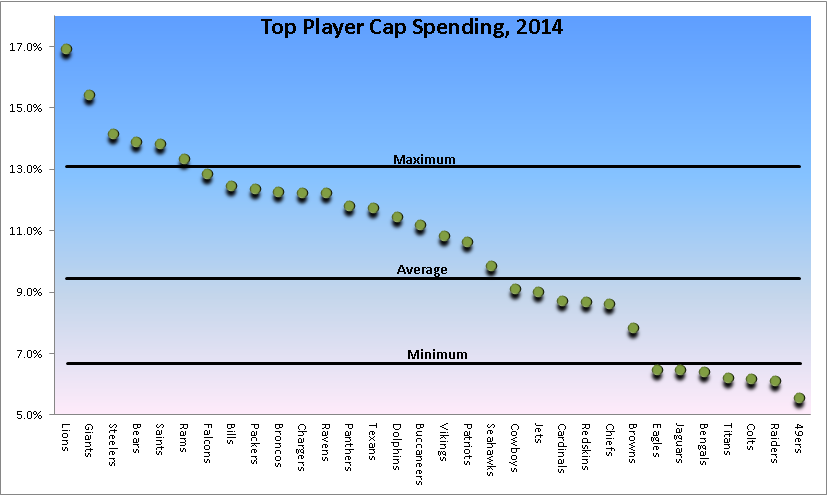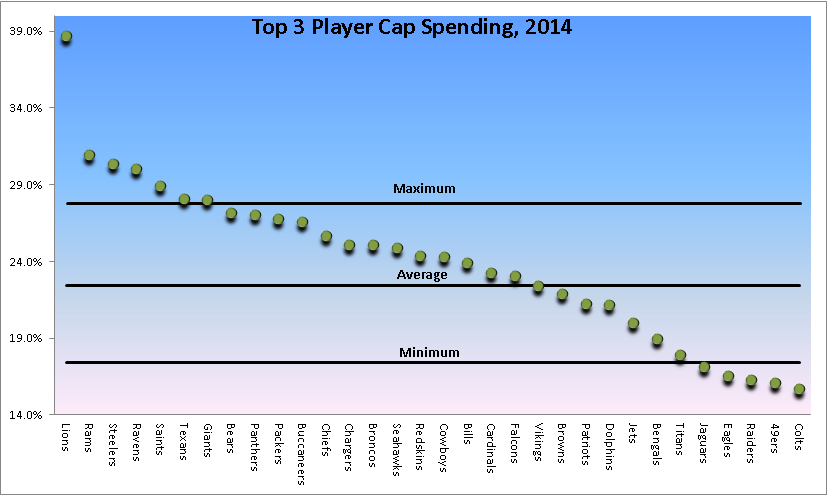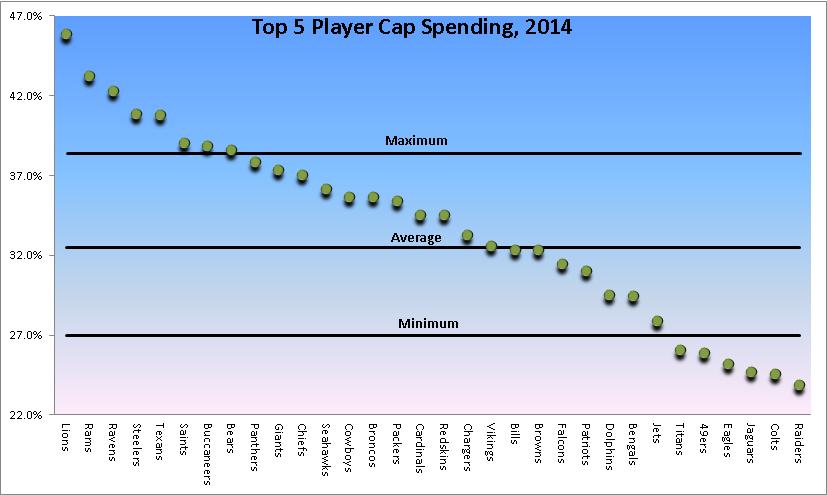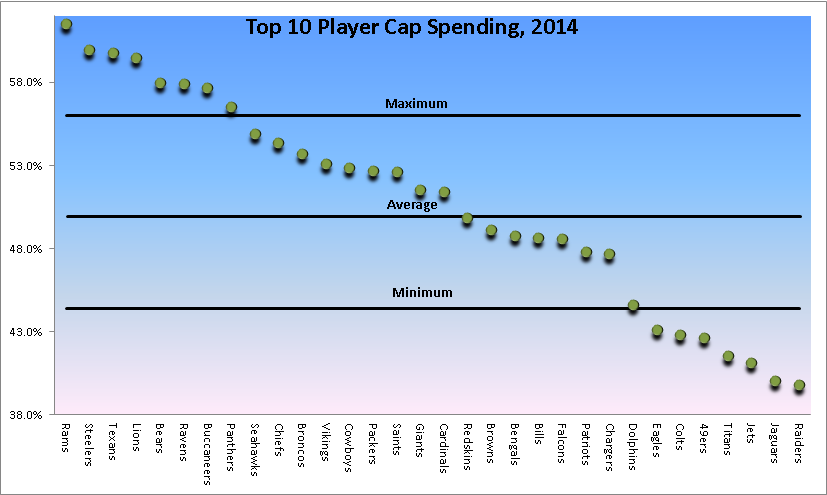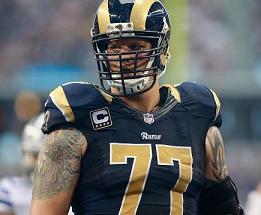The numbers are now in for the Rams star Defensive End Robert Quinn and it’s a very interesting contract that I think benefits both sides. First let us go over the particulars of the contract. Quinn receives a signing bonus worth $4,776,774 to go along with a guaranteed base salary of $608,608 (prorated from a base rate of $646,646) and a guaranteed roster bonus in 2015 of $10,233,201. That brings Quinn’s full guarantee to $15,618,583. The reason for the small bonus and salary in 2014 is likely to maintain a near identical salary cap charge as the Rams are right up against the salary cap this year, though in general the Rams are not a team big on the signing bonus.
In 2015 Quinn has a base salary that will become fully guaranteed that is worth $5,555,555 (yes in case you were wondering the Rams made sure to get every palindrome reference possible in this contract). For all realistic purposes this is guaranteed. In 2016 and 2017 his base salaries are $7,777,777 and $6,161,616 and can become guaranteed if on the roster at the start of that League Year. There are also roster bonuses of $2,424,242 and $3,633,363 that will also be guaranteed. His cash salary in 2018 and 2019 is $11,444,412 and $12,932,332.
[adsenseyu6]
The contract is closer to what I believed JJ Watt would have signed with the Texans in that the player is probably undervalued in terms of production but the window is open for another mega-contract in a few years which comes with the shorter term extension. The guarantee package for Quinn is decent with the early vesting roster bonuses helping protect his salary. I think these are all benefits for the player. The Rams get Quinn essentially on their terms (minimal signing bonus, vesting guarantees, contract flexibility) and I think at a bargain price, all things considered.
In the following chart I compare the new money in Quinn’s contract to that received by other players who signed extensions this year. Those players are JJ Watt, Patrick Peterson, Richard Sherman, and Joe Haden. Since Quinn’s contract is 4 years I just want to look at the 4 year values to compare apples to apples. For players with two years remaining under contract, such as Quinn, I consider the first two years as year -1 and year 0 of the contract. Year 1 is when the extension kicks in. The colors represent the likelihood of earning the salary with a green essentially meaning it’s a virtual certainty, yellow meaning the player has to maintain a solid level of play, and red meaning the player will need to be at a high level to continue the contract.
You can see the favorable structure, from the Rams perspective, of the deal with Quinn compared to some of the other players. Despite the higher annual value on the contract Quinn will trail all but Sherman in terms of new money made during the original contract years and in the first year of the contract. By year 2 Quinn will trail all of the newly signed cornerbacks in earnings, a trend that continues through year 3. By year 4 he will pull ahead of Sherman and barely ahead of Haden.
[adsenseyu2]
Because of the low signing bonus in the contract Id would consider Quinn’s earning potential to be less than the corners just based on contract structure. That does not mean he will not get there, but he will basically have each year of his contract tied solely to his performance on the field. Though the early vesting roster bonus is a nice addition for Quinn the Rams have already set a precedent through the release of Cortland Finnegan that the bonus will not be a barrier to release.
For the other pass rushers looking for new contracts Quinn’s deal is probably a major disappointment Once teams get past the annual value of the contract, there is not much there besides potential guarantees on a relatively short term extension. The contract by no means built on the Watt contract that way the cornerback contracts, which all shattered the existing market, built upon each other. More importantly it also did not advance the market beyond what already existed.
Why do I say that? Lets look at this contract compared to the extension signed by Clay Matthews in 2013 (he had one year remaining) and new contract signed by Charles Johnson in 2011. Both were signed at a time when the salary cap was significantly lower and neither as productive as Quinn.
Granted these players had varying degrees of leverage (Quinn by far had the least), but the effective impact is that his contract is not all that different than what already existed in the NFL. I do think that brings up the major question of if it is truly beneficial for the player to be looking for a contract extension so quickly when the team holds all the leverage. That was another point I discussed in the Watt contract that a player is going to give a discount in these spots, the question is just how much. Johnson gave up none because he was going to be a free agent. Matthews had one year left. Quinn had two.
Matthews does have $500,000 per year tied to games active which Quinn does not which does make Quinn’s contract structure more player friendly, but overall Matthews seemed to get the stronger and more secure contract. It just does not have the upside value, if all things are equal and the players continue to be strong. I have to think if Quinn gets through the 15 remaining games his contract would have shattered the Matthews one.
[adsenseyu2]
I’d say that this also sends the message to the other rushers (and rookie contract guys too) that the Watt contract may be looked at as an aberration. The Texans did not do much to utilize their leverage in that case and seemed to give in on a number of key parameters. Maybe that did not do as much to change the market as I had thought.
The Rams were likely not coming close to the Mario Williams/Watt numbers which is probably what helped lead to this contract. It’s the same approach I thought would happen in Houston where the compromise would be a high valued contract but for a shorter term. In that respect this is a very good contract for the player. Johnson and Matthews do give up years of free agency for those big initial cash flows. Quinn does not and if he maintains exceptional levels of play he will cash in again and likely get close to Watts numbers over the same time period, especially if the salary cap keeps inflating. The other two are stuck at figures agreed upon years before.
For that reason I’d classify the contract as a good deal for both sides, but by no means is this a game changer. It’s really just opening a door for large cash flows on the front end of a short term contract rather than forcing a player into a longer term deal, which backend years are rarely seen from a practical perspective but could hinder a player if he maintains high levels of play for his career.
[adsenseyu4]

